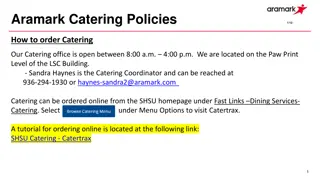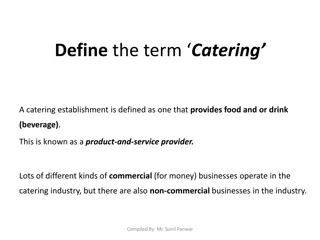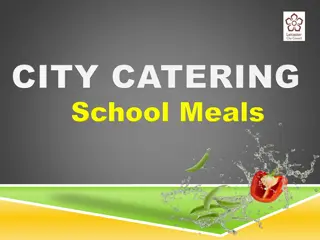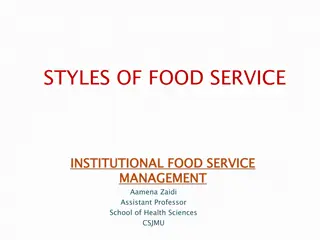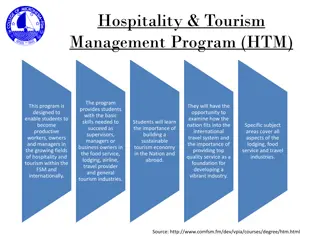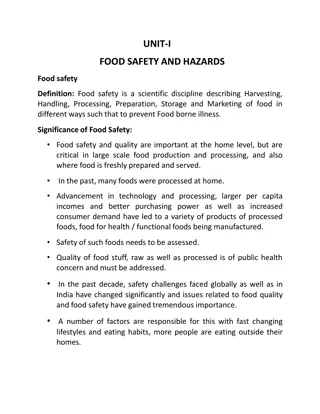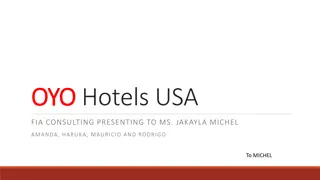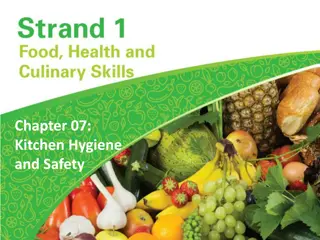Understanding Food Safety in Hospitality and Catering
Learners will explore food-related causes of ill health in hospitality and catering, including microbes and bacteria that can lead to food poisoning. Factors such as warmth, time, food supply, and moisture create ideal conditions for harmful bacteria to thrive and cause illness. This topic covers food labeling laws, visible and non-visible symptoms of food-induced ill health, and food safety legislation.
Download Presentation

Please find below an Image/Link to download the presentation.
The content on the website is provided AS IS for your information and personal use only. It may not be sold, licensed, or shared on other websites without obtaining consent from the author. Download presentation by click this link. If you encounter any issues during the download, it is possible that the publisher has removed the file from their server.
E N D
Presentation Transcript
1.4 Food safety 1.4 Food safety in hospitality in hospitality and catering and catering 1.4.1 Food related causes of ill health 1.4.2 Symptoms and signs of food- induced ill health 1.4 Food safety in hospitality and catering
1.4.1 1.4.1 1.4.2 Food related causes and symptoms of ill health 1.4.2 Food related causes and symptoms of ill health In this topic, learners will gain knowledge and understanding of the following areas: Factors which cause ill health Food poisoning causes Food allergies Food intolerances Visible and non-visible symptoms of food-induced ill health Food labelling laws Food safety legislation 1.4 Food safety in hospitality and catering
1.4.1 Food related causes of ill health 1.4.1 Food related causes of ill health Microbes The word microbe is short for micro-organisms, which are very small life forms that are only clearly visible under a microscope. In the right conditions, micro-organisms can multiply and cause food spoilage. . Some of them have the potential to be harmful to humans. 1.4 Food safety in hospitality and catering
1.4.1 Food related causes of ill health 1.4.1 Food related causes of ill health Bacteria Bacteria are small, single-celled organisms that are found almost everywhere. Most bacteria are harmless. However, some types of bacteria are bad and cause food poisoning. These are called pathogenic bacteria. Food poisoning can make you extremely ill and, in some cases, can be fatal. People with weakened immune systems, pregnant people, newborn babies and older adults may face additional complications. 1.4 Food safety in hospitality and catering
1.4.1 Food related causes of ill health 1.4.1 Food related causes of ill health Bacteria WARMTH TIME FOOD MOISTURE ? What are the ideal conditions necessary for bacteria to grow and cause food poisoning? What are the ideal conditions necessary for bacteria to grow and cause food poisoning? 1.4 Food safety in hospitality and catering
1.4.1 Food related causes of 1.4.1 Food related causes of ill health: bacteria ill health: bacteria A supply of food Bacteria need a supply of nutrients and energy from food to enable them to multiply. If food is not available to bacteria, they cannot grow and multiply. 1.4 Food safety in hospitality and catering
1.4.1 Food related causes 1.4.1 Food related causes of ill health: bacteria of ill health: bacteria A supply of moisture Bacteria need water for all their biological processes. If moisture is not available to bacteria, they cannot grow and multiply. 1.4 Food safety in hospitality and catering
1.4.1 Food related causes of 1.4.1 Food related causes of ill health: bacteria ill health: bacteria Warm temperature Bacteria grow and multiply fastest in warm temperatures: their optimum optimum (best) temperature is 37 37o oC C. If it is too hot too hot, the bacteria will be destroyed. If it is too cold very slowly, until they become dormant ( asleep ), which means they are still alive but not active. too cold, the bacteria will grow and reproduce 1.4 Food safety in hospitality and catering
1.4.1 Food related causes 1.4.1 Food related causes of ill health: bacteria of ill health: bacteria Time It takes time for bacteria to grow and multiply, and the more suitable the conditions, the faster they will do so. 1.4 Food safety in hospitality and catering
1.4.1 Food related causes of ill health: 1.4.1 Food related causes of ill health: bacteria bacteria Under the ideal conditions, a single bacterium can multiply to create millions of bacteria in just a few hours! The single-celled bacterium divides into two identical daughter cells. This process is called binary fission binary fission. 1.4 Food safety in hospitality and catering
1.4.1 Food related causes of ill health: 1.4.1 Food related causes of ill health: bacteria bacteria High risk foods Foods are grouped according to whether there is a low risk of allowing pathogenic bacteria to grow and multiply. Foods with a high level of moisture Foods with a high level of protein low risk or high risk high risk ACTIVITY ...................................... \ Make a list of foods that you think would be high risk. 1.4 Food safety in hospitality and catering
1.4.1 Food related causes of ill health: 1.4.1 Food related causes of ill health: bacteria bacteria High risk foods ACTIVITY ACTIVITY . . . .. .... Identify which of these foods are high risk foods and justify your answers. 1.4 Food safety in hospitality and catering
1.4.2 Symptoms and signs of food 1.4.2 Symptoms and signs of food- -induced ill health induced ill health ACTIVITY ACTIVITY . ... . .. Brainstorm the main visible symptoms visible symptoms and non non- -visible symptoms visible symptoms of food poisoning. Non-visible symptoms Visible symptoms Feeling sick Aches and pains Bloating Vomiting Chills Cramps Sweating Nausea Stomach- ache Fever and chills Fatigue Diarrhoea 1.4 Food safety in hospitality and catering
How to tell if you have food poisoning (symptoms) | NHS (youtube.com) 1.4 Food safety in hospitality and catering
1.4.1 1.4.1- -1.4.2 Food related causes and symptoms of ill health 1.4.2 Food related causes and symptoms of ill health ACTIVITY ACTIVITY .. . . .. Using the internet, research visible and non-visible signs and symptoms and sources of different types of pathogenic bacteria. Food poisoning bacteria Food poisoning bacteria Non Non- -visible symptoms and visible symptoms and signs signs Visible symptoms and signs Visible symptoms and signs Found in Found in Cramps, abdominal pain, aches and pains. Diarrhoea and fever. Meat, poultry, eggs, unpasteurised milk, meat pie and leftovers. Salmonella Salmonella Clostridium perfringens Clostridium perfringens Staphylococcus aureus Staphylococcus aureus Campylobacter Campylobacter E. coli E. coli Listeria Listeria Bacillus cereus Bacillus cereus 1.4 Food safety in hospitality and catering
1.4.1 1.4.1- -1.4.2 Food related causes and symptoms of ill health 1.4.2 Food related causes and symptoms of ill health Salmonella fact file Non-visible symptoms Visible symptoms Diarrhoea and fever Cramps, abdominal pain, aches and pains Salmonella is found in: raw eggs and undercooked poultry processed foods unpasteurised milk and dairy products pets poor sanitation. 1.4 Food safety in hospitality and catering 1.4 Food safety in hospitality and catering
1.4.1 1.4.1- -1.4.2 Food related causes and symptoms of ill health 1.4.2 Food related causes and symptoms of ill health Campylobacter fact file Non-visible symptoms Visible symptoms Diarrhoea and vomiting Cramps, abdominal pain and fatigue Campylobacter is found in: the intestines of animals and poultry raw and undercooked meats unpasteurised milk contaminated water. 1.4 Food safety in hospitality and catering
1.4.1 1.4.1- -1.4.2 Food related causes and symptoms of ill health 1.4.2 Food related causes and symptoms of ill health Bacillus cereus fact file Non-visible symptoms Visible symptoms Diarrhoea and vomiting Cramps and nausea Bacillus cereus is found in: reheated rice and dried goods: cereal, sauces, herbs and spices raw meats: beef, turkey and seafood. 1.4 Food safety in hospitality and catering 1.4 Food safety in hospitality and catering
1.4.1 1.4.1- -1.4.2 Food related causes and symptoms of ill health 1.4.2 Food related causes and symptoms of ill health E. coli fact file Non-visible symptoms Visible symptoms Diarrhoea and vomiting Cramps and fever E. coli is found in: raw and undercooked meats and poultry unpasteurised milk and dairy products contaminated water. 1.4 Food safety in hospitality and catering
1.4.1 1.4.1- -1.4.2 Food related causes and symptoms of ill health 1.4.2 Food related causes and symptoms of ill health Listeria fact file Non-visible symptoms Visible symptoms Diarrhoea and fever Aches and pains Listeria is found in: ready to eat foods, prepacked sandwiches, p t and delicatessen foods unpasteurised milk and dairy products, and soft cheeses soil, sewage and contaminated water. 1.4 Food safety in hospitality and catering
1.4.1 1.4.1- -1.4.2 Food related causes and symptoms of ill health 1.4.2 Food related causes and symptoms of ill health Staphylococcus aureus fact file Non-visible symptoms Visible symptoms Diarrhoea, lumps and sores on the skin Nausea Staphylococcus aureus is found: in unpasteurised milk and dairy products on the skin and in the nose. 1.4 Food safety in hospitality and catering
1.4.1 1.4.1- -1.4.2 Food related causes and symptoms of ill health 1.4.2 Food related causes and symptoms of ill health Clostridium perfringens fact file Non-visible symptoms Visible symptoms Diarrhoea Cramps Clostridium perfringens is found in: raw meats, poultry and food cooked in large batches soil on root vegetables intestines of animals. 1.4 Food safety in hospitality and catering 1.4 Food safety in hospitality and catering
1.4.1 Food related causes of ill health 1.4.1 Food related causes of ill health Chemicals: pesticides Herbicides and pesticides are sprayed on crops to prevent damage from insects. Crops in the EU are tested for residues of both, as high levels of them can cause nerve damage, damage to unborn babies, dermatitis and other health problems. Chemicals: fertiliser Crops are fertilised for a higher yield; the fertilisers used can pollute water and, at high levels, can be toxic to humans. 1.4 Food safety in hospitality and catering
1.4.1 Food related causes of ill health 1.4.1 Food related causes of ill health Chemicals: additives Food additives can be chemical or natural. They help to improve the shelf life, colour and flavour of food. Some additives are banned in the UK as they can cause hyperactivity and cancers. Chemicals: packaging Chemicals found in packaging, such as BPA, can seep into foods in certain conditions; they may have negative effects on health. 1.4 Food safety in hospitality and catering 1.4 Food safety in hospitality and catering
1.4.1 Food related causes of ill health 1.4.1 Food related causes of ill health Chemicals: cleaning Sometimes, using chemicals to clean food machines can leave residues on the food. Unlabeled cleaning products could be mistaken for ingredients and put into food causing toxic poisoning. 1.4 Food safety in hospitality and catering
1.4.1 Food related causes of ill health 1.4.1 Food related causes of ill health Food intolerance A food intolerance is when the body has a chemical reaction as a result of eating or drinking a certain food, making it difficult to digest. Food intolerance can sometimes cause painful reactions when eating food. It can cause nausea, bloating, wind, stomach cramps and diarrhoea. 1.4 Food safety in hospitality and catering
What's a Food Allergy -- and What's Not? | Body Stuff with Dr. Jen Gunter | TED (youtube.com) 1.4 Food safety in hospitality and catering
1.4.1 Food related causes of ill health 1.4.1 Food related causes of ill health Common food intolerances Flavour enhancers such as MSG: Found in some Chinese foods, instant noodles, dried soup mix, some processed meats and canned vegetables Fruits: Aspartame: Strawberries, citrus fruits and tomatoes Some sugar free products Lactose: Eggs: Gluten: Wheat, barley and rye Wine: Dairy products, including milk, cheese and yoghurt Particularly egg whites Particularly red wine ACTIVITY ACTIVITY . . .. Jamie has recently been diagnosed with a food intolerance. Create a suitable leaflet/poster to give to Jamie detailing the condition and how to manage it. 1.4 Food safety in hospitality and catering
Pain and bloating in the abdomen Constant tiredness and weakness Staff area Staff area Service area Service area Nausea Storage area Storage area 1.4.1 Food related 1.4.1 Food related causes of ill health causes of ill health Symptoms of food intolerances Symptoms of food intolerances Preparation and cooking area Preparation and cooking area Eczema and dry skin conditions Diarrhoea Food intolerance is difficult for a doctor to diagnose, but it can make people feel unwell most of the time. Symptoms of a food intolerance could include one or more of the following: Wash and clean area Wash and clean area Muscle and joint aches and pains Headache
1.4.1 Food related causes of ill 1.4.1 Food related causes of ill health health Food intolerance: lactose Inability to digest lactose, a type of sugar found in milk. This causes diarrhoea, wind and bloating after eating or drinking it. People with lactose intolerance must manage their condition by avoiding drinking milk and eating dairy products such as yoghurt, cheese, butter and cream. They must look at food labels to see if milk has been used as an ingredient in food products. It is possible to buy dairy products with reduced lactose or no lactose, for example milk and yoghurt. 1.4 Food safety in hospitality and catering
Why are some People Lactose Intolerant? (youtube.com) 1.4 Food safety in hospitality and catering
1.4.1 Food related causes of ill 1.4.1 Food related causes of ill health health Food intolerance: coeliac disease Coeliac disease is a reaction to gluten; when gluten is digested, the immune system will attack, damaging the gut and limiting nutrient absorption. Coeliac disease can cause a variety of symptoms; weight loss, constipation, abdominal pain, bloating, diarrhoea, wind, rash and painful joints. Gluten is found in many food products and comes from wheat, barley and rye. Individuals with coeliac disease must avoid eating any foods that contain gluten, such as wheat flour that is used to make bread, cakes and biscuits. There are many gluten-free food products available in food shops. 1.4 Food safety in hospitality and catering
What is celiac disease? (youtube.com) 1.4 Food safety in hospitality and catering
1.4.1 Food related causes of ill health 1.4.1 Food related causes of ill health Food allergies An allergic reaction is a response from the body s immune system, which usually occurs within minutes of eating or touching the food. Some people can have a delayed allergic reaction which can take hours to develop. When a person has encountered a certain food or eaten a certain food, this reaction can cause severe symptoms and anaphylaxis and, in some cases, can be fatal. 1.4 Food safety in hospitality and catering
1.4.1 Food related causes of ill health 1.4.1 Food related causes of ill health Common food allergens ACTIVITY: ACTIVITY: THINK, PAIR, SHARE .. Think of as many allergens as possible. Discuss you answers with a peer/in a small group. Share your findings with the class. 1.4 Food safety in hospitality and catering
MUSTARD TREE NUTS PEANUTS GLUTEN CELERY 1.4.1 Food 1.4.1 Food related causes of related causes of ill health ill health Common food allergens EGGS MILK FISH CRUSTACEANS MOLLUSCS: Clams, scallops, oysters, squid, snails and cockles SESAME SOYA SULPHITES LUPIN
1.4.1 Food related causes of ill health 1.4.1 Food related causes of ill health Symptoms of food allergies ACTIVITY ACTIVITY .. From the list of food allergy symptoms provided, note which symptoms are visible and non-visible. Swelling of the face, lips and throat Breathing difficulties and wheezing Dry tongue and throat Swollen tongue Itchy tongue and throat Bloated stomach Rash Nausea Vomiting Coughing Painful stomach cramps Feeling faint or lightheaded Chills Visible signs of food allergies Non-visible signs of food allergies 1.4 Food safety in hospitality and catering
1.4.1 Food related causes of ill health 1.4.1 Food related causes of ill health Food allergies: anaphylaxis Anaphylaxis: life threatening life threatening Confusion Difficulty breathing Wheezing Fast heart rate Feeling faint Clammy, sweaty skin Fainting or losing consciousness An EpiPen is a self-injecting device used in an emergency to treat life- threatening allergic reactions. ACTIVITY ACTIVITY Watch the video, and in your own words, write step-by-step instructions for treating someone suffering from anaphylaxis. 1.4 Food safety in hospitality and catering
What is anaphylaxis? | Anaphylactic shock | First Aid | iHASCO (youtube.com) 1.4 Food safety in hospitality and catering
1.4.1 Food related causes of ill health 1.4.1 Food related causes of ill health Food safety legislation All hospitality and catering provisions should be aware of the following: Food Labelling Regulations Food Safety Act Food Safety (General Food Hygiene) Regulations 1.4 Food safety in hospitality and catering
1.4.1 Food related causes of ill health 1.4.1 Food related causes of ill health Food Labelling Regulations ACTIVITY ACTIVITY .. .. . .. The purpose of food labelling is to inform and educate consumers about the food product they choose to buy. The label also protects the consumer, manufacturer and retailer by requiring certain information to be shown on the label. Study a food label and identify and explain why the information is shown on the label. 1.4 Food safety in hospitality and catering 1.4 Food safety in hospitality and catering
The name of the manufacturer The name of the food must not be misleading to the consumer If there is a picture of the food product, the product inside must look the same and not be misleading The net weight/quantity of the food product Food and drink labelling is extremely important in order to manage food safety. The labelling must be permanent, clear and easy to read. There are several legal requirements in place when it comes for food labelling: 1.4.1 Food related 1.4.1 Food related causes of ill health causes of ill health Food Labelling Regulations 1.4 Food safety in hospitality and catering
Information about nutrition Contact details of the manufacturer, distributor or retailer of the food product Foods with 'use by' and 'best before' dates cannot be sold past the dates displayed List of ingredients (in descending order) with allergens in bold Cooking and heating instructions Storage advice bold, italics or in different colour 1.4.1 Food related 1.4.1 Food related causes of ill health causes of ill health A food label should also state: the place of origin and the percentage of alcohol it contains warnings: noting if the product contains aspartame, additives (E numbers), caffeine, skimmed milk, polyols or sweeteners. Food Labelling Regulations 1.4 Food safety in hospitality and catering
ACTIVITY ACTIVITY .. . ..... You work in a small bakery and the safety of its customers is of the utmost importance. They have asked you to provide food labelling training to all new members of staff. Watch the video and read the newspaper article before creating a training resource suitable for the new employees. Calls for Better Food Labelling at Pret A Manger as Teenager Dies From Allergic Reaction | GMB (youtube.com) 1.4 Food safety in hospitality and catering
Pret Pret a a Manger Manger will an an allergic allergic reaction Natasha Ednan-Laperouse, 15, went into cardiac arrest on a flight after buying a sandwich at Heathrow Airport in 2016. Theresa May called for a review of food labelling laws on Tuesday in the wake of her death. Clive Schlee, Pret chief executive, said again the firm was "deeply sorry". "I said we would learn from this tragedy and ensure meaningful changes happen," he said. In October 2021, new legislation all ingredients, ingredients, including reaction after will list list all after eating eating a a Pret including allergens, Pret sandwich sandwich. . allergens, on on its its freshly freshly made made products products following following the the death death of of a a teenager teenager who who had had You can read the full article here: Pret a Manger to label products after allergy death - BBC News called Natasha s Law was passed; this law came into force following an extensive petition campaign by the parents of Natasha Ednan- Laperouse. Food labelling regulations and Natasha's law are in place to prevent food-induced ill health. Did you know? 1.4 Food safety in hospitality and catering
1.4.1 Food related causes of ill health 1.4.1 Food related causes of ill health Food Labelling Regulations Nutritional information enables customers to make informed choices about the foods they eat. The product's nutritional information is displayed in a specific order: energy per 100g or ml (calories and kilojoules), fat, saturates, carbohydrates, sugars, protein, salt, vitamins and minerals. Many companies have made the nutrition list easier by using the traffic light labelling system. The red red, amber amber and green green traffic light system helps the customer to identify whether there are high, medium or low levels of one or more of the following: fats, saturates, sugars and salt. WATCH ME! 1.4 Food safety in hospitality and catering
1.4.1 Food related causes of ill health 1.4.1 Food related causes of ill health Food Safety Act The Food Safety Act provides a structure for food establishments to follow in order to ensure that foods are safe for people to eat. All food businesses that prepare, transport, store, handle, serve and sell foods must follow the regulations set out in the Act. The main responsibilities of all food businesses under the Food Safety Act are: to ensure food businesses do not include anything in food, remove anything from food or treat food in any way that would have a detrimental effect on the health of the people who eat it to ensure that the food served or sold by food businesses is of the nature, substance or quality that consumers would expect to ensure that food is labelled, advertised and presented in a way that is not false or misleading. Businesses that do not fulfill the responsibilities outlined in the Food Safety Act are committing an offence. 1.4 Food safety in hospitality and catering
1.4.1 Food related causes of ill health 1.4.1 Food related causes of ill health Food Safety (General Food Hygiene) Regulations The Food Safety Regulations are in place to prevent food and beverages from causing ill health. The Food Safety Regulations are a legal requirement for all food provision. The main aspects of the regulations are: produce and handle food safely to make sure it is safe to eat analysis and control of any food safety risk hazard (HACCP) keep records of all suppliers to be able to trace food ingredients. 1.4 Food safety in hospitality and catering
1.4.1 Food related causes of ill health 1.4.1 Food related causes of ill health Food Safety (General Food Hygiene) Regulations Food premises must: be maintained to a good standard on a regular basis be well lit and ventilated include toilets and adequate hand washing facilities ensure that all areas and facilities are clean and free from pests ensure storage areas are maintained; monitor and control the temperatures of fridges and freezers ensure equipment is maintained and cleaned ensure that staff are hygienic and trained. 1.4 Food safety in hospitality and catering
STARTER/PLENARY ACTIVITY STARTER/PLENARY ACTIVITY ..................... Instructions: Instructions:Identify the food labelling symbols. Topic: Food labelling 1.4 Food safety in hospitality and catering



